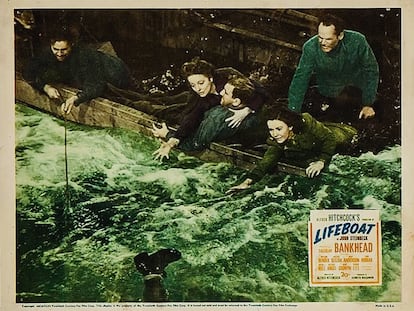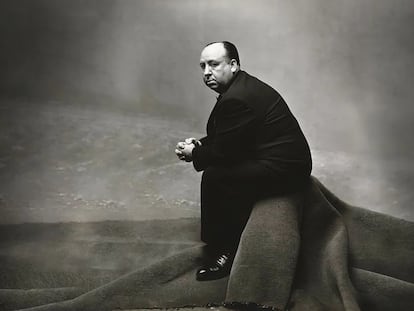A useless $100-million copy: When they dared to remake ‘Psycho’
When some executives asked Gus Van Sant 25 years ago what he wanted to do for his next film, he replied that he wanted to duplicate, frame by frame, a universally known masterpiece, and they said: okay
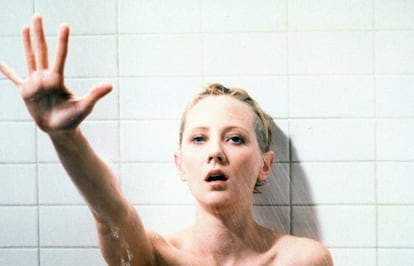

December 4, 1998, marked the release of Psycho, a film with a script as precise as a Swiss watch and masterful direction, full of sequences and shots that are studied in film and art schools all over the world as an example of cinematographic virtuosity. Then, soon after that, it entered the lists of the worst films released that year. The reason? There was already a Psycho that was known and admired worldwide. Both critics and the public agreed that making another one made no sense, and the film was a failure. Now, this story could end here, but it’s the footnotes what make this failure the most interesting and valuable experiment in the history of cinema.
To understand how we got to that point, we have to go back about ten years. In 1989, director Gus Van Sant had released Drugstore Cowboy, which was praised by the critics and which managed to double its tight budget. On the podcast WTF With Marc Maron, the director explained that after that, every time a film executive asked him what he wanted to do next, he used to reply that he wanted to film Psycho again, just the same, frame by frame. The executives laughed. They kept laughing for years, until in 1997 Good Will Hunting became a great success, receiving nine Oscar nominations. When they asked him the same question and he gave them the same answer, they told him it was a brilliant idea and gave him $60 million so he could do it (adjusted for inflation, that would amount to more than $113 million of today’s dollars).
An update of Psycho actually made sense when it was announced in 1998. The masked killer genre had been brought back to life thanks to the Scream saga and all its illegitimate offspring, and Psycho is considered the mother (get it?) of them all. Adapting a classic to a new generation, with stars that young people adored at the time (Vince Vaughn, Viggo Mortensen and Julianne Moore) seemed like a great idea and justified the investment. Filming it exactly the same was an understandable eccentricity: who would dare to touch precisely that film, probably the most iconic in the history of cinema?

Joseph Stefano, the screenwriter of the original, gave the project his blessing and rewrote the script. In truth, he just added a couple of things. The changes were few, but they brought a necessary modernization in two aspects. One is economic: the protagonist, Marion, does not steal $40,000 (which in 1998 would not have gotten her very far) but $400,000. Another is a politically correct tweak: in the final sequence of the original, when a psychologist explains to the protagonists (and the audience) what happened, one of the police officers remarks, “He’s a transvestite!” That was taken out. For a few months, Gus Van Sant’s Psycho was one of the most talked about and anticipated films of the year. Then it came out, people saw it, and everyone hated it because it was exactly what its director said it was going to be: a copy.
Still, not everyone hates it. “This experiment with Psycho is proof that Van Sant is a great artist, as he gave himself the freedom to jump into the void without a net at the risk of being stoned by the critics,” says Diana Larrea, a Spanish artist who has worked with Hitchcockian appropriationism in several of her works. “Gus Van Sant could have with Psycho the same intentions that guide us appropriationist artists when we want to evoke in the viewer’s mind a timeless icon to transgress the concept of originality and deconstruct it. It is about proposing a discourse around the concept of copy, so postmodern, that it demystifies the modern idea of ‘original’ to exalt that of the replica.”

Perhaps the punkest thing about Gus Van Sant’s Psycho is how the opening credits declare: “Directed by Gus Van Sant.” The director admitted to Marc Maron that yes, there was some transgression there. It was not really about learning from Hitckcock, he explained. It was that in the 1990s there was a running joke that executives preferred to make a sequel than an original film because there was less risk in sticking to a story that the public already knew, so they kept looking for ways to do it. In any case, Psycho is neither a joke nor a parody: everyone involved took it very seriously (and not many people finance $100 million jokes). Van Sant has never explained what exactly his Psycho is: it would seem that he wants to keep a veil of mystery around this experiment, and he is onto something. Everyone has an opinion on why he did it. The most interesting is perhaps that of the specialized website SlashFilm: “No one is quite sure why Van Sant wanted to remake Psycho other than to prove that he could.”
“We must not forget that Gus Van Sant has always been a strange director, capable of mixing the classic with the experimental,” says Andrés S. Paredes, author of one of the most complete studies on the Psycho saga ever written in Spanish: Yo soy Norman Bates (I am Norman Bates). “He had just made Good Will Hunting, a great Oscar winner; then he made the acceptable Finding Forrester; two years later he returned with Gerry, a very strange film... my conclusion is that Van Sant is a clear example of a director who makes a film for the audience and the critics and then a more experimental one for himself. Sometimes it turns out better, like Elephant, and sometimes worse, like in Paranoid Park. The Psycho remake falls into that category of strange film, made for himself.” Larrea adds: “Recreating a work of art with extreme fidelity reveals, on one hand, a deep love for what is being reproduced, and at the same time it causes a very powerful sense of déjà vu in the audience, which takes us back to another time and place and brings back an emotion from the past. Besides, I believe that the more a myth is used, the more it retains its essential meaning and its power in the world of our collective illusions.”
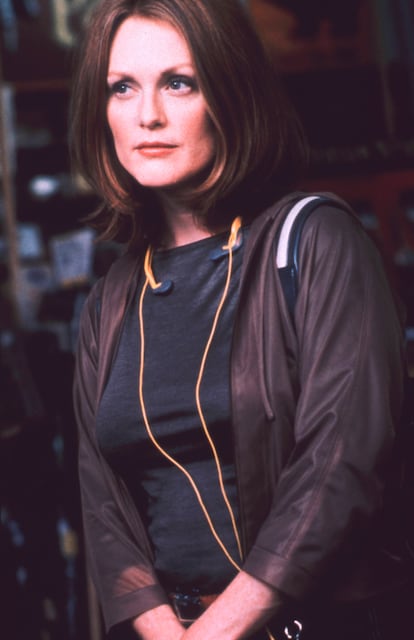
The experiment leaves a strange aftertaste. First, in an era in which remakes and sequels were flooding the box office (Scream 2 had been released the previous year, Scream 3 would come the following year and that same year Hitckcock was also revisited in a new version of The Perfect Crime), Psycho feels like a slap in the face that seems to ask the viewers directly If what they are seeing makes any sense to them, given the senselessness of watching a movie that already existed and which nobody needed to make again. “The film audience is not used to this type of mental games,” says Larrea. “[Gus Van Sant’s Psycho] is a contemporary artistic piece that would be more at home in a museum than in a movie theater. However, I do believe that it is a product of its time because it is very postmodern.”
“I think Van Sant seeks to create chaos, to disorient the viewer,” adds Paredes. “If you pay attention, it happens throughout the entire movie. There are small details that are not exactly the same, sound effects that are out of place, gestures that don’t make sense where they are... Van Sant forces the machinery over and over again to make the viewer feel uncomfortable. If we remember it, it’s because he did it well.” Indeed, this Psycho is not a complete carbon copy of the original; there are some shots, nods and situations that vary and are key to understanding it.
Despite being set in the present (that is, in 1998), the rhythm, the sets, the dialogues and the morals of some characters are stuck in the 1960s (the script, keep in mind, is the same). Anne Heche dresses and talks like a woman from the 1960s, but Julianne Moore dresses and talks like a woman from the 1990s. Marion asks her lover to meet, “but respectably, in my house, with my mother’s picture on the mantel,” evoking an outdated morality – and, right after that, Van Sant shows Viggo Mortensen’s naked body in a deliciously gratuitous way, a return to the sexual liberation of the present. And although Vince Vaughn as Norman Bates displays a much more elegant and explicit mannerism that at first invites us to think that Van Sant is approaching his protagonist as a tormented, closeted homosexual, then, in the sequence in which he spies on Marion through a hole, he audibly masturbates.
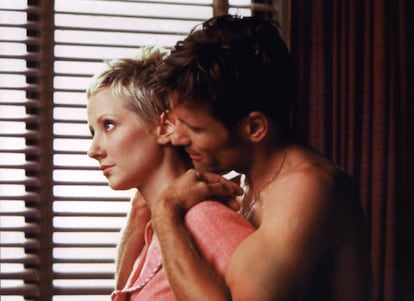
The most talked about of Van Sant’s additions are in the two key scenes of the film: a stormy sky in the murder in the shower, and a woman with a blindfold and a sheep in a cart during the murder of the private detective on the stairs. At the time, some critics contemptuously dismissed them as images designed to satisfy an audience that was used to MTV. Van Sant has never explained them; the closest he has come was in the documentary Psycho Path, a detailed and hilarious account of the filming where he says that as they worked on the film, it became clear to them that they were after the uncontrollable and symbolic “logic of a nightmare.” That’s all.
From a technical standpoint, the movie also operates on dual fronts: it begins with a spectacular aerial tracking shot above the city of Phoenix that, from the sky, enters a hotel room (something Hitchcock wanted to do, but lacked the means). However, when Van Sant shows characters driving, he resorts to the rudimentary technique of putting an actor in a stationary car in front of a screen that shows a moving road (and makes sure that it is very noticeable). Paredes refers to the film as “an experiment in metacinema. After the success of Scream, which parodies horror cinema, Van Sant decides to go one step further and not only talks about horror cinema from the outside, but also makes the film itself an analysis of that horror.” The documentary Psycho Path shows all the actors and technicians constantly watching the original Psycho on a monitor on the set of the new Psycho, something with undoubtedly comic overtones. Editor Amy Duddlestone provides the most honest and valuable statement about all this: “I can’t even begin to describe, like, my first day, not really knowing what I should do, whether I should copy the way everything was edited originally,” she says. “We cut it together the way they originally had it, and then you kinda look at it and go, ‘Kinda slow!’”

She is right, and that is the most valuable lesson that we can learn from this Psycho: the same film changes if we place it 40 years apart, because it is us, the viewers, who have changed. Psycho, the one from 1998, seems much slower than the original, sometimes even tedious, even though they last the same and the same things happen in both. There is a simple explanation for this: the original had to let its 1960 audience breathe after each horrifying scene. They needed time to come to terms with what they had just witnessed. This accounts for the existence of an almost eight-minute long sequence in which Norman thoroughly cleans the bathroom after Marion’s murder; Hitchcock used it to let that impressionable 1960s viewer recover from the brutal death of the film’s star. Meanwhile, the audience from 1998 had already seen countless bloody scenes where stars and strangers alike died, and there was no sensitivity left to hurt. Thus, the scene feels much longer and baffling than in the original.
“I don’t think it’s a good movie, and I don’t think the final product makes its intentions clear,” says Paredes, “but it is a crucial film for understanding horror cinema and an example of how time puts everything in its place. Nobody remembers the remake of The Perfect Crime that was released the same year, but any horror fan worth their salt at least knows about the existence of the remake of Psycho. And if someone takes the time to watch it closely, they will appreciate the differences, the innovations, that pulse between the modern and the classic that Van Sant brings.”
In the end, Psycho is a failed film and a formidable experiment. It proves how excellently constructed and written characters are nothing without actors with the right charisma, how a black and white film changes completely if seen in color, giving the viewers a reality check by putting them in front of the most perpetuated vice in the industry of entertainment: telling the same story a hundred times. It proves that following the exact steps of a genius is pointless if you are not the genius. That with Psycho they stole an idea to show how ugly it is to steal. The mistake was releasing this very expensive creation in movie theaters; its place is in MoMA. This year Robert Downey Jr. threatened to remake Vertigo. I hope he dares.
Sign up for our weekly newsletter to get more English-language news coverage from EL PAÍS USA Edition
Tu suscripción se está usando en otro dispositivo
¿Quieres añadir otro usuario a tu suscripción?
Si continúas leyendo en este dispositivo, no se podrá leer en el otro.
FlechaTu suscripción se está usando en otro dispositivo y solo puedes acceder a EL PAÍS desde un dispositivo a la vez.
Si quieres compartir tu cuenta, cambia tu suscripción a la modalidad Premium, así podrás añadir otro usuario. Cada uno accederá con su propia cuenta de email, lo que os permitirá personalizar vuestra experiencia en EL PAÍS.
¿Tienes una suscripción de empresa? Accede aquí para contratar más cuentas.
En el caso de no saber quién está usando tu cuenta, te recomendamos cambiar tu contraseña aquí.
Si decides continuar compartiendo tu cuenta, este mensaje se mostrará en tu dispositivo y en el de la otra persona que está usando tu cuenta de forma indefinida, afectando a tu experiencia de lectura. Puedes consultar aquí los términos y condiciones de la suscripción digital.
More information
Archived In
Últimas noticias
Most viewed
- Reinhard Genzel, Nobel laureate in physics: ‘One-minute videos will never give you the truth’
- Oona Chaplin: ‘I told James Cameron that I was living in a treehouse and starting a permaculture project with a friend’
- Pablo Escobar’s hippos: A serious environmental problem, 40 years on
- Why we lost the habit of sleeping in two segments and how that changed our sense of time
- Chevy Chase, the beloved comedian who was a monster off camera: ‘Not everyone hated him, just the people who’ve worked with him’
